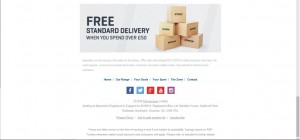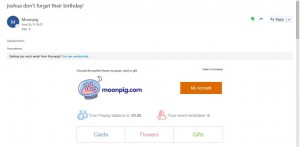There are millions of blogs on the internet, so how else can you communicate your message with the consumer? Once you’ve created credible and intriguing content, then social media channels offer a way to ensure consumers are talking about your brand. Egger (2014) explains that social media sharing offers the consumer a way to ‘express your favourable view’ and even ‘share the contents of a blog with your followers.’ It is important to note that for blogs to add value to a brand, then they must remain social and the content should be converted by the consumer into something that creates further discussion. Chiles (2015) further supports this notion as he conveys that social media engagement is ‘the transmission of information between contacts in a process of involvement’. The key message from Chiles (2015) is that social media provides the consumer with an involvement, and therefore it is important content exposed to them is perceived as relevant and useful.
The theory of involvement and social media is consolidated with Chaffey’s six channels model (Chaffey, 2010). Audience participation and customer feedback are crucial elements of communicating with consumers. A fashion brand therefore, can communicate through Twitter activity, Facebook live posts, and Snapchat stories. This creates an involvement with the consumer as they can comment on what they are seeing, or involve a friend and spread the word.
In terms of using initiatives to enhance a fashion brands social media strategy; the simple steps that are essential are sustaining a Facebook, Twitter, Instagram and Snapchat account. This is the most powerful marketing tool and relating back to Chaffey’s model, these initiatives can help create other aspects such as online partnership through sponsorships or even opt-in email through links posted on social media (Nussey, 2004).
The challenge is ultimately to ‘direct, shape and focus on how customers see you’ (Kotler & Pfoertsch, 2006). This means content and the platform chosen, dictate how the consumer will perceive the brand. Caballar (2016) evaluates the different platforms available for sharing content on social media. The following graphic details the findings of her survey asking ‘Which social share buttons do you use the most?’. Are you surprised at the findings? And what would your answer be?
Improving a fashion brands’ Instagram is a vital channel of communication with the consumers. Best practice is a perfect example of how a picture can paint a thousand words, and take on a meaning of its own. For example, the consumer sending in pictures wearing the clothing serves as a positive influence on future purchases by other consumers. Celebrity endorsements are becoming common place, but choosing the correct personnel adds great value to a marketing strategy.
Dele Alli (Tottenham and England Footballer) wearing Fresh Ego Kid Cap;
Marcus Rashford (Manchester United and England Footballer) in a powerful Nike marketing photo;
Snapchat
Snapchat is a marketing tool that should be maximised by fashion brands. The instant nature of the uploads and ease of reaching out to the consumer make it the number one marketing tool available today. Arthur (2016) explains that Snapchat has ‘150 million daily users’ of which ‘60% are within the 18-34 demographic’. This is a key area of the market for fashion brands as they are the segment with ‘the fastest growing spending power’. When marketing a fashion brand, the consumer is essentially interested in a luxury product and therefore targeting consumers with high levels disposable income is ideal.
Check out this video which explains why fashion brands should ‘capture the moment!’.
(Source: WallStreetJournal, 2015).
Examples of Best Practice – Fashion Brand Social Media
Fred Perry Instagram – Creates good discussion and volume of shares/likes
(Click to enlarge image)
Asos Customer Service Twitter – Personalisation of replies and speedy help
(Click to enlarge image)
Adidas Originals – Creative video upload to increase shares/comments
(Click to enlarge image)
10 Laws of Social Media Marketing
Check out this informative video which explains the key principles that businesses must follow to gain benefits from their social media marketing;
(Source: Entrepreneur, 2017)
Johnson (2011) interestingly purports that 50% of consumers who follow a brand on Twitter are more likely to buy from that brand. A greater benefit to this, is the reported ‘60% of followers who would recommend the brand through word of mouth marketing and social media sharing’. Therefore it is critical to ensure a strong social media presence, as in the 21st Century this is the most visible line of communication with the target market.
Risks of Social Media Sharing – Twitter
Business Queensland (2017) suggest there are causes for concern when using Twitter for a corporate purpose. The use of Twitter is highly advantageous, although caution must be taken once the content is shared;
- Spamming – Content shared on Twitter should not be ‘for the sake for it’. It should be focused, intriguing and fresh.
- Disappointing Audience – If content does not meet the needs of the consumer e.g. lack of colour variations in a new line, then the replies on social media are going to be negative. It is incredibly easy for a consumer to unfollow on social media so aim to segment market with blogs, tweets and Facebook uploads.
- Trying to force positive comment – Leave the shares and comments on Twitter unedited. If you aim to force positive comment on the brand then trust will be lost and brand not seen as honest.
- Brand Damage – If poor quality, poor customer service or distasteful posts go viral, then the reputation of the brand will be affected detrimentally.
- Maintaining and Monitoring presence – Worst thing a fashion brand could do is just leave social media presence as it is. Must be measured in terms of impact e.g. retweets, shares, comments. If the number captured are not of value to brand then how can you improve this?
- Unauthorised Tweets – Corporate Twitter activity must be from authorised personnel only and be compliant.
The key takeaway from this topic should be the powerful nature of social media, on a fashion brands digital marketing strategy. Simpson (2016) explains almost 60% of fashion and beauty brands have an influencer marketing strategy in place, while a further 21% plan to invest in it over the next 12 months. It is highly important therefore, to utilise this channel of communication when marketing your fashion brand!
Thanks for reading! You can follow me on Twitter for more Digital Marketing content- @JR_DIGMARK. You can also check out the #bbsdigmarket to see more fun digital marketing articles!
References
Arthur, R. (2016). 10 Fashion Brands Nailing Their Snapchat Content Strategy. Available: https://www.forbes.com/sites/rachelarthur/2016/11/30/10-fashion-brands-nailing-their-snapchat-content-strategy/#122cd07c4e9e. Last accessed 16th Apr 2017.
Chaffey, D. (2010). Applying organisational capability models to assess the maturity of digital-marketing governance. Journal of Marketing Management. 26 (3), p187-196.
Chiles, D (2015). Social Media Best Practices: Engagement Netiquette. London: David Paul Chiles Publishing. p20-22.
Egger, B (2014). Social Media Strategies for Investing. Massachusetts: Adams Media. p54-57.
Johnson, J. (2011). Twitter Users Who Follow Brands Are More Likely To Buy Products. Available: http://www.blogherald.com/2011/10/20/twitter-users-who-follow-brands-are-more-likely-to-buy-products-study/. Last accessed 16th Apr 2017.
Kotler, P & Pfoertsch, W (2006). B2B Brand Management. New York: Springer. p187.
Nussey, B (2004). The Quiet Revolution in Email Marketing. New York: iUniverse. p247.
Simpson, J. (2016). Eight influencer marketing stats for fashion & beauty brands. Available: https://econsultancy.com/blog/67443-eight-influencer-marketing-stats-for-fashion-beauty-brands/. Last accessed 15h Apr 2017.





















